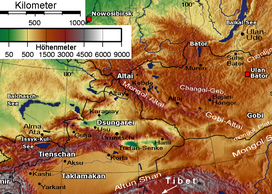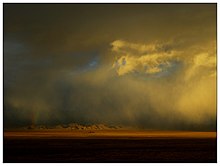Altyn-Tagh
| Altyn-Tagh | |
|---|---|
| Altyn Mountains, Altyn Shan, A'erjin Shan, A-erh-chin Shan | |
 Eastern part of Altun Shan at bottom of elevation map | |
| Highest point | |
| Peak | Sulamutag Feng, Xinjiang |
| Elevation | 6,245 m (20,489 ft) |
| Coordinates | 37°55′N 87°23′E / 37.917°N 87.383°E |
| Dimensions | |
| Length | 805 km (500 mi) WSW-ENE[1] |
| Geography | |
 | |
| Country | China |
| Provinces | |
| Range coordinates | 38°36′N 89°0′E / 38.600°N 89.000°E[1] |
| Borders on |
|
| Biome | Desert |
Altyn-Tagh (also Lower Mountains or Altyn )[nb 1] is a mountain range in Northwestern China that separates the Eastern Tarim Basin from the Tibetan Plateau. The western third is in Xinjiang while the eastern part forms the border between Qinghai to the south and Xinjiang and Gansu to the north.
Altun Shan is also the name of a 5,830 metres (19,130 ft) mountain near the eastern end of the range, the highest point in Gansu.
Etymology
[edit]Altyn Tag means Lower Mountain in Turkic, and A'erjin Shan (
Geography
[edit]
A series of mountain ranges run along the northern edge of the Tibetan Plateau. In the west are the Kunlun Mountains. About halfway across the south side of the Tarim Basin, the Altyn-Tagh Range diverges northeast while the Kunluns continue directly east, forming a relatively narrow "V".[nb 2] Inside the "V" are a number of endorheic basins. The eastern end of the Altyn-Shan is near the Dangjin Pass on the Dunhuang-Golmud road in far western Gansu. East of the Altyn-Tagh the border range rises to the Qilian Mountains. The range separates the Tarim Basin, to the north, and Lake Ayakkum, to the south. The range can be divided into three portions. The southwest portion borders the Kunlun Mountains and is very rugged, with peaks reaching more than 6,100 metres (20,000 ft) and many perennial snow fields. The central portion is lower in elevation, around 4,000 metres (13,000 ft). The eastern portion is higher in elevation, about 5,000 metres (16,000 ft) and consists of a group of smaller ranges oriented in a south-east to north-west trend.[2]
Along the northern side of the mountains ran the main Silk Road trade route from China proper to the Tarim Basin and westward. The Altyn-Tagh and Qilians were sometimes called the Nan Shan ('south mountains') because they were south of the main route. Near the east end of the Altyn-Shan, the Gansu or Hexi Corridor ends and the Silk Road splits. One branch follows the Altyn-Tagh along the south side of the Tarim Basin while the other follows the north side.
The southwestern part of the Altyn-Tagh range reaches snowy peaks of up to 6,245 metres (20,489 ft), although it descends to an average of 4,000 metres (13,000 ft) in the narrow middle and eventually rises up to average 5,000 metres (16,000 ft) as it meets the Qilian Mountains.
There are a dearth of rivers and streams in these mountains, due to the aridity of the region. The western portion has some small streams that either head north into the desert or south into Lake Ayakkum. The remainder of the range is lacking in rivers.[2]
Intermontane endorheic basins
[edit]
Inside the V-shaped area between the Altyn-Tagh and the main Kunlun range (which in this area is called Arka-Tagh) a number of endorheic basins are located.
Within southeastern Xinjiang, the main of these basins is the Kumkol Basin (Chinese: 库木库里
The two main lakes in this basin are the saline Lake Aqqikkol (also Ajig Kum Kul,[6] Achak-kum; Chinese:
Farther east, in northwestern Qinghai, the much larger Qaidam Basin starts between the Altyn-Tagh and the Kunlun and extends almost to the east side of the plateau; the Altyn-Tagh separates the west side of this basin from the Kumtagh Desert.
Major Peaks
[edit]The four highest peaks are Sulamutag Feng (6,245 metres (20,489 ft)), Yusupu Aleketag Shan (6,065 metres (19,898 ft)), Altun Shan (5,830 metres (19,130 ft)) and Kogantag (4,800 metres (15,700 ft)).[7][9]
Economic development
[edit]
China National Highway 315 crosses the Altyn-Tagh on its way between Qinghai and Xinjiang.
The Golmud-Korla Railway crosses the Altyn-Tagh as well. The project, involving the construction of the 13.195 km-long Altyn-Tagh Tunnel (
Notes
[edit]- ^ Chinese:
阿 尔金山 , Pinyin: A'erjin Shan, Wade–Giles: A-erh-chin Shan; Uyghur: ئالتىن تاغ)[2] - ^ See e.g. the map in Fig. 1 in Meng & Fang's Cenozoic tectonic development of the Qaidam Basin in the northeastern Tibetan Plateau[3]
- ^ The Chinese-based spelling (pinyin) for this place name, "Kumukuli Basin" is often used in English. When trying to produce a Turkic-like spelling for this name, authors occasionally transcribe it as "Kumukol Basin", as in the map in Fig. 2 in Meng & Fang's Cenozoic tectonic development of the Qaidam Basin in the northeastern Tibetan Plateau,[4] but more often as "Kumkol",[5] or "Kumkuli".
Footnotes
[edit]- ^ a b Cohen 1998, p. 86
- ^ a b c Hoiberg 2010, p. 1
- ^ Meng & Fang 2008, p. 2
- ^ Meng & Fang 2008, p. 3
- ^ Zheng 1997, p. 229
- ^ Holdich 2006, p. 288
- ^ a b Peakbagger 2013
- ^ a b Li 2000, pp. 230–231
- ^ de Ferranti, Jurgalski & Maizlish 2011
- ^
格 库铁路 新 疆段首 条 隧道 顺利贯通 Archived 1 December 2017 at the Wayback Machine (The first tunnel of the Xinjiang section of the Golmud-Korla Railway has been drilled through), 2017-10-31 - ^
国家 重点 铁路建 设项目 格 库铁路 全 线开通 (Dec, 2020))
References
[edit]- Cohen, Saul B., ed. (1998) [1952]. "Altunshan". The Columbia Gazetteer of the World. New York, NY: Columbia University Press. ISBN 0-231-11040-5.
- de Ferranti, Jonathan; Jurgalski, Eberhard; Maizlish, Aaron (2011). "Sinkiang – Xinjiang". peaklist.com. Archived from the original on 23 August 2010. Retrieved 6 February 2014.
- Hoiberg, Dale H., ed. (2010). "A-erh-chin Mountains". Encyclopædia Britannica. Vol. I: A-Ak – Bayes (15th ed.). Chicago, Illinois: Encyclopædia Britannica, Inc. ISBN 978-1-59339-837-8.
- Holdich, Sir Thomas (2006) [1906]. Keltie, J. Scott (ed.). Tibet, the Mysterious. Elibron Classic Series. Adamant Media Corporation. ISBN 1-4212-8483-9.
- Li, Bosheng (2000). "Nature Conservation". In Du Zheng, Qingsong Zhang; Wu, Shaohong (eds.). Mountain Geoecology and Sustainable Development of the Tibetan Plateau. GeoJournal library. Vol. 57. Springer Science + Business Media Dordrecht. doi:10.1007/978-94-010-0965-2. ISBN 978-94-010-3800-3.
- Meng, Qing-Ren; Fang, Xiang (2008). Burchfield, B. C.; Wang, Erchie (eds.). "Cenozoic Tectonic Development of the Qaidam Basin in the Northeastern Tibetan Plateau". Special Paper – Geological Society of America. 444. Geological Society of America: 1–24. doi:10.1130/2008.2444(01). ISBN 978-0-8137-2444-7.
- Peakbagger (2013). "Altun Shan". Retrieved 6 February 2014.
- Zheng, Mianping (1997). An introduction to saline lakes on the Qinghai-Tibet plateau. Monographiae Biologicae. Vol. 76. Springer. ISBN 978-0-7923-4098-0.
Further reading
[edit]- National Geographic Atlas of China. Washington, DC: National Geographic. 2009. ISBN 978-1-4262-0327-5.
External links
[edit]- NASA photos of Ayakkum Lake and surrounding area
